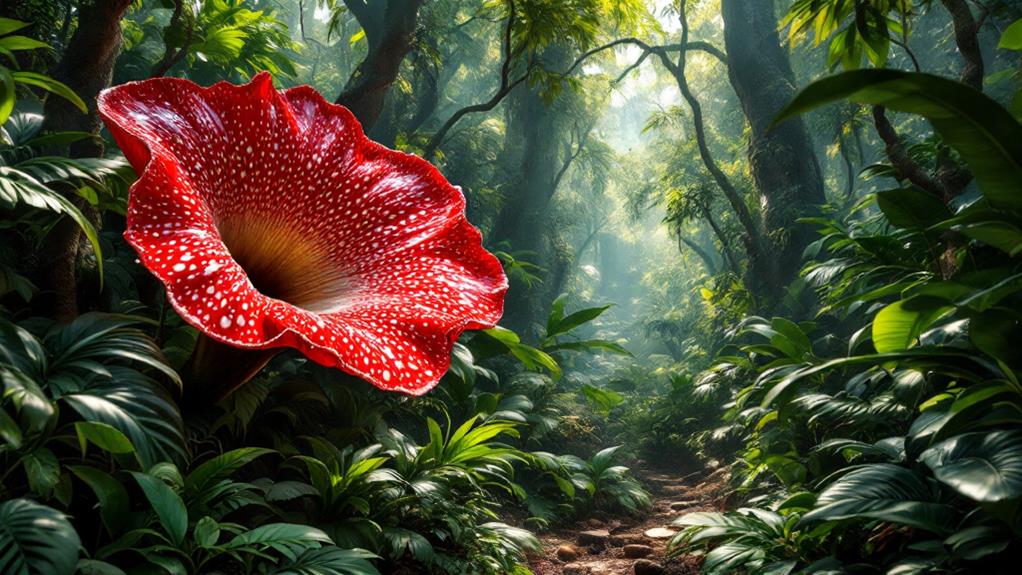The Deadliest Plants on Earth: Plants You Should Avoid
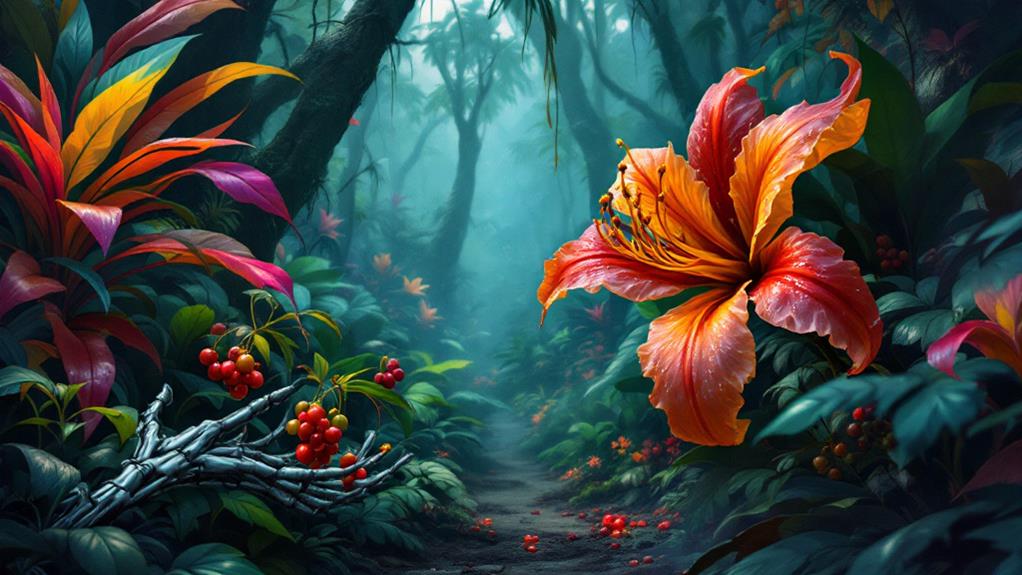
Nature's beauty can be deceptive, hiding some of the world's deadliest plants. You should be aware of the manchineel tree, whose every part is toxic, and water hemlock, with its lethal roots. Angel's trumpet and deadly nightshade cause dangerous hallucinations, while the castor bean plant contains ricin, one of the most potent toxins known. Australia's gympie gympie tree inflicts excruciatingly painful stings, and oleander's deceptive beauty masks its toxicity. White snakeroot and poison hemlock have left their mark on history, causing widespread illness and even Socrates' death. Exploring these plants further reveals fascinating stories of danger and intrigue.
Manchineel: The Most Dangerous Tree
From within the lush forests of the Caribbean and Central America, the manchineel tree stands out as nature's most treacherous plant. You might mistake it for an ordinary tree with its deceptive foliage, but don't be fooled. Every part of this tree is toxic, from its bark to its leaves and fruit.
The manchineel's deadly sap is its most dangerous weapon. If you touch it, you'll experience severe skin irritation, blistering, and burning. Even standing under the tree during rainfall can cause chemical burns as water carries the toxic sap. Inhaling smoke from burning manchineel wood can lead to respiratory problems and blindness.
Its small, apple-like fruits are equally hazardous. A single bite can cause severe swelling of the throat, potentially leading to suffocation. Indigenous peoples once used the tree's sap for poison arrows, highlighting its lethal potency.
If you're exploring tropical areas, stay vigilant and avoid this tree at all costs. Look for warning signs often placed near manchineel trees to protect unsuspecting visitors. Remember, its innocent appearance belies its true nature as one of the world's deadliest plants.
Water Hemlock's Lethal Roots
Lurking in wetlands and along stream banks across North America, water hemlock stands as one of the continent's most poisonous plants. You'll find this deceptively innocent-looking member of the carrot family growing up to eight feet tall, with small white flowers clustered in umbrella-shaped heads.
Don't be fooled by its resemblance to edible wild plants like Queen Anne's lace. Water hemlock contains toxic levels of cicutoxin, a powerful neurotoxin concentrated in its roots. Even a small amount of root ingestion can be fatal to humans and animals alike. Symptoms of poisoning appear rapidly, often within 15 minutes, and include nausea, vomiting, and seizures.
If you're foraging or hiking in areas where water hemlock grows, it's essential to learn how to identify this plant. Look for its distinctive hollow stem with purple streaks or spots, and compound leaves with serrated edges. Remember, the entire plant is poisonous, but the roots are especially deadly. Never attempt to harvest or consume any part of water hemlock, as misidentification can have lethal consequences.
Angel's Trumpet's Hallucinogenic Deception
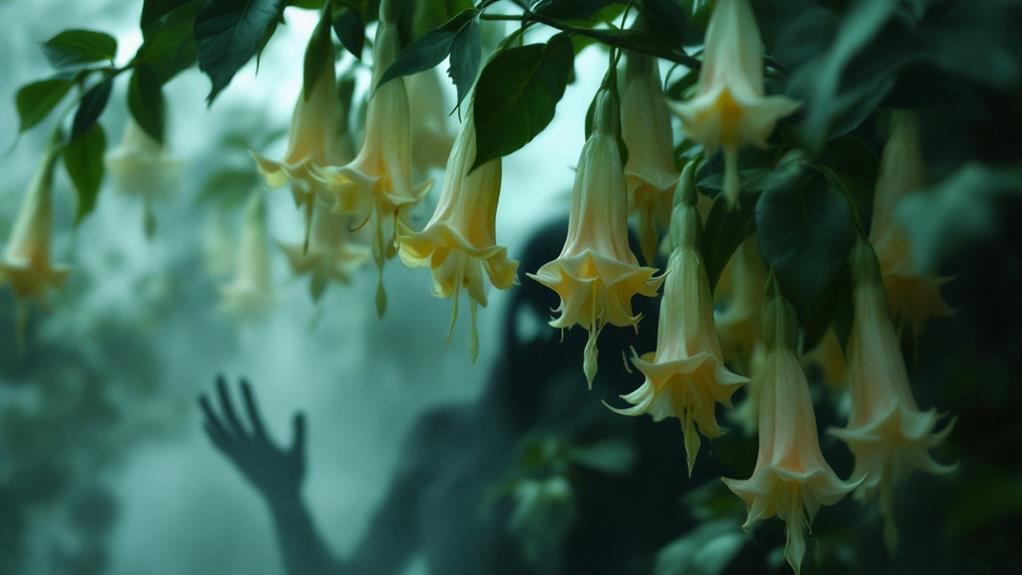
While its name might evoke celestial imagery, the Angel's Trumpet is far from heavenly. This beautiful but deadly plant, native to South America, has large, trumpet-shaped flowers that can be white, yellow, pink, or orange. Don't let its alluring appearance fool you; every part of this plant is highly toxic.
The Angel's Trumpet contains dangerous alkaloids, including scopolamine and atropine, which are responsible for its psychoactive properties. These compounds can cause intense hallucinations, delirium, and even death if ingested or absorbed through the skin. You'll experience severe toxic effects, including dilated pupils, dry mouth, blurred vision, and increased heart rate. In extreme cases, it can lead to paralysis, coma, and respiratory failure.
Despite its dangers, some people seek out the Angel's Trumpet for its hallucinogenic effects. This is extremely risky, as it's nearly impossible to control the dosage or predict the intensity of the experience. Even handling the plant can be dangerous, as its toxins can be absorbed through cuts or abrasions. If you encounter this deceptive beauty in gardens or the wild, admire it from a safe distance.
Deadly Nightshade's Toxic Allure
The Deadly Nightshade lives up to its ominous name. This deceptively beautiful plant, also known as belladonna, contains toxic compounds that can be lethal even in small doses. You'll find it lurking in woodlands and shady areas, its glossy black berries tempting unsuspecting victims.
Don't be fooled by its allure; every part of this plant is poisonous. The berries, leaves, and roots contain alkaloids like atropine and scopolamine, which can cause severe symptoms. If ingested, you might experience dilated pupils, blurred vision, and hallucinations. As the toxins take hold, you could face difficulty breathing, rapid heartbeat, and even death.
Historically, Deadly Nightshade has been used for both medicinal and sinister purposes. Its hallucinogenic properties made it popular in witchcraft and as a deadly poison. Today, it's still used in controlled amounts for certain medications, but you should never attempt to use it yourself.
If you encounter this plant in the wild, admire it from afar. Remember, its toxic allure is best appreciated through knowledge rather than direct contact.
Castor Bean's Ricin Menace
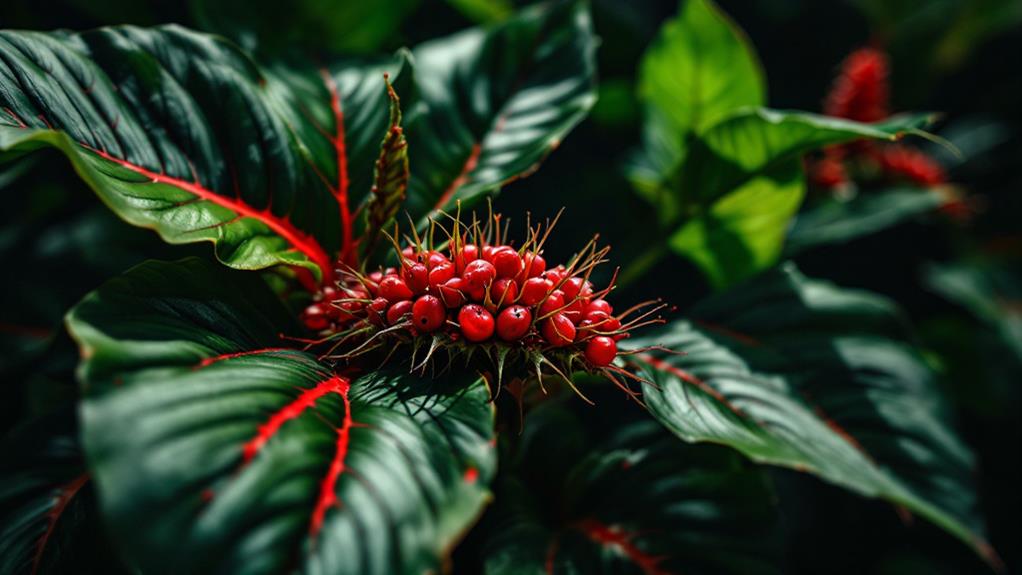
From one deadly beauty to another, we turn our attention to the castor bean plant. This ornamental plant, with its large palmate leaves and spiky seed pods, harbors a sinister secret: ricin, one of the most potent toxins known to mankind.
You'll find castor bean plants adorning gardens and environments worldwide, but don't let their attractive appearance fool you. Every part of this plant is poisonous, with the seeds containing the highest concentration of ricin. The toxicity in children is particularly alarming, as ingesting just a few seeds can be fatal.
The ricin extraction process is surprisingly simple, making it a potential bioterrorism threat. When the seeds are crushed or chewed, the ricin is released, inhibiting protein synthesis in cells and leading to organ failure. Symptoms of ricin poisoning include severe gastrointestinal distress, followed by liver, spleen, and kidney failure.
If you suspect ricin poisoning, seek immediate medical attention. There's no antidote, but supportive care can be life-saving. While castor bean plants have industrial uses, it's essential to handle them with extreme caution and keep them out of reach of children and pets.
Gympie Gympie: The Suicide Plant
Deep in the rainforests of Australia, a seemingly innocuous plant lurks with a sting so potent it's earned the nickname "suicide plant." The gympie gympie, scientifically known as Dendrocnide moroides, is a large shrub or small tree that's covered in fine, silica-tipped hairs.
If you brush against the gympie gympie, you'll experience immediate and intense pain. The stinging hairs inject a potent neurotoxin that causes a painful rash, burning sensation, and swelling. What's worse, the pain can last for months or even years, leading to lasting trauma for its victims.
The plant's sting is so severe that it's been known to kill dogs and horses. Even dried specimens can retain their stinging ability for years. If you're unfortunate enough to encounter this plant, don't attempt to remove the hairs with your bare hands. Instead, use a wax hair removal strip or adhesive tape to carefully pull them out.
While fatalities in humans are rare, the gympie gympie's sting can cause severe allergic reactions and even hospitalization. If you're hiking in Australian rainforests, stay alert and avoid this dangerous plant at all costs.
Oleander's Deceptive Beauty
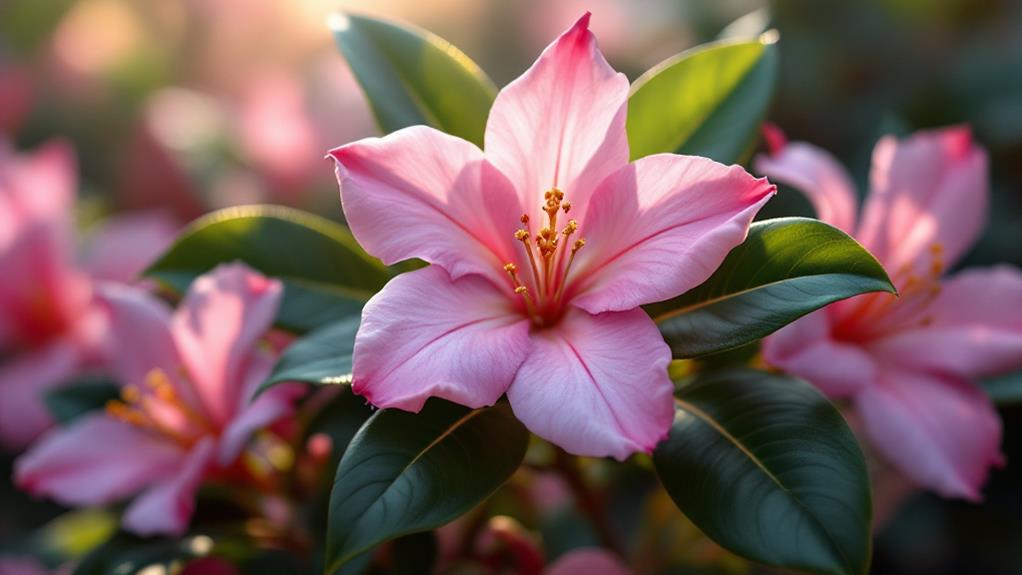
With its clusters of beautiful pink or white flowers, oleander might seem like a perfect addition to your garden. But don't be fooled by its deceptive appearance. This plant is one of the most toxic in the world, with every part of it containing deadly cardiac glycosides.
Oleander's toxic leaves and stems can cause severe reactions if ingested, and even touching the plant can lead to skin irritation. It's so potent that there have been reports of people falling ill after eating honey made by bees that fed on oleander nectar. Despite its dangers, oleander is widely cultivated for its ornamental value.
To stay safe around oleander, remember these key points:
- Never eat any part of the plant or use it for cooking skewers
- Wear gloves when handling oleander and wash your hands thoroughly afterward
- Keep children and pets away from areas where oleander grows
If you suspect oleander poisoning, seek immediate medical attention. Symptoms can include nausea, vomiting, irregular heartbeat, and even death in severe cases. Don't let this plant's beauty deceive you – it's a killer in disguise.
White Snakeroot's Historical Impact
Tragedy struck early American settlers due to a seemingly innocuous plant called white snakeroot. This perennial herb, native to North America, caused widespread devastation among pioneer communities, particularly in the Ohio River Valley during the 18th and 19th centuries.
Despite its Native American medicinal uses for treating fever and diarrhea, white snakeroot harbors a deadly secret. When livestock, especially cattle, graze on the plant, they accumulate a potent toxin called tremetol in their meat and milk. Unsuspecting settlers who consumed these contaminated products often fell victim to a mysterious illness known as "milk sickness."
Historical livestock fatalities were common, but the human toll was even more severe. Thousands of settlers, including Abraham Lincoln's mother, Nancy Hanks Lincoln, succumbed to milk sickness before its cause was identified. The plant's toxicity wasn't fully understood until the early 20th century, when a farmer's wife, Anna Pierce Hobbs, worked with a Shawnee healer to uncover the connection between white snakeroot and the deadly illness.
Today, you're unlikely to encounter milk sickness, but white snakeroot remains a potent reminder of nature's hidden dangers.
Poison Hemlock's Ancient Legacy
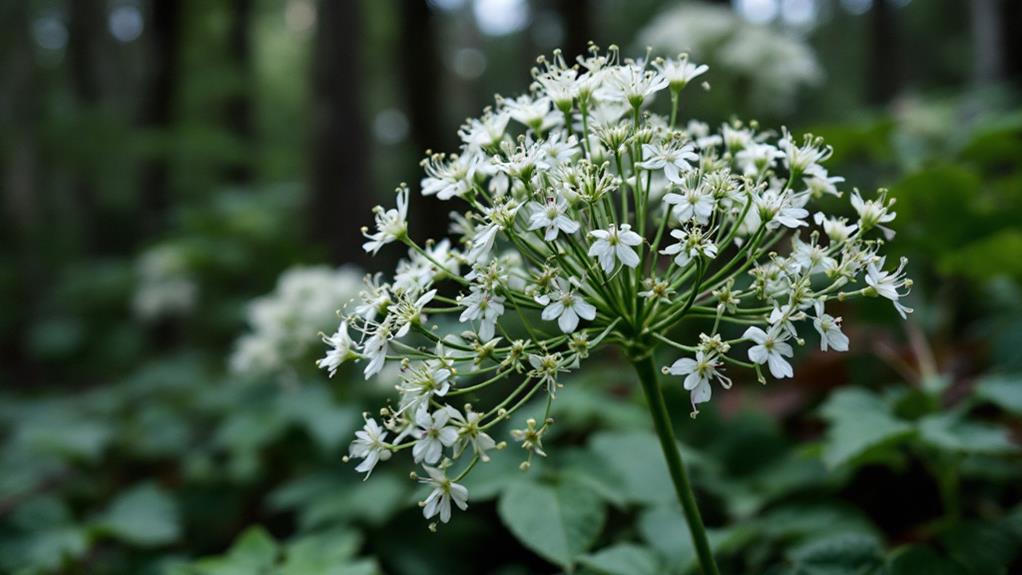
While white snakeroot claimed lives in early America, another deadly plant has left an enduring mark on human history. Poison hemlock, scientifically known as Conium maculatum, has been infamous since ancient times. You've likely heard of its most famous victim, the philosopher Socrates, who was sentenced to death by drinking a hemlock-based poison in 399 BCE.
Despite its lethal reputation, poison hemlock has had ancient medicinal uses and mythological associations. The Greeks and Romans believed it had connections to the underworld and used it in various rituals. However, its toxicity made it a dangerous remedy, often causing more harm than good.
Today, you should be aware of poison hemlock's characteristics to avoid accidental exposure:
- White flowers in umbrella-shaped clusters
- Purple-spotted, hollow stems
- Fern-like leaves with a musty odor when crushed
You'll find poison hemlock growing in moist areas across North America and Europe. It is vital to recognize this plant, as all parts are toxic, and even small amounts can be fatal. If you suspect hemlock poisoning, seek immediate medical attention.

